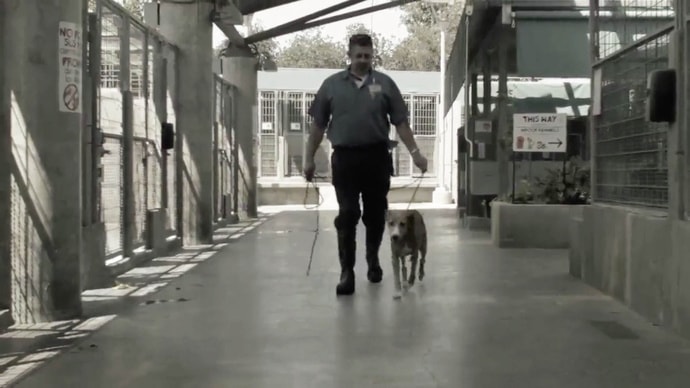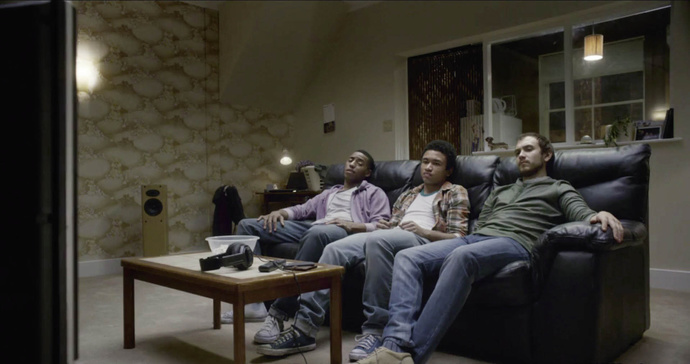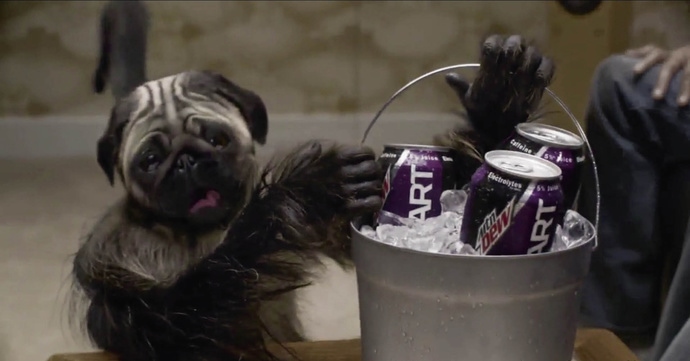
12th August 2016
David Lubars
One of the most celebrated creatives in the today’s ad industry today, David Lubars is Chief Creative Officer, BBDO Worldwide and Chairman, BBDO North America.
You have to be fast, you have to be cheap, and it still has to be great.
Since starting his career in 1981, David has won every major creative award out there multiple times over, his haul of honors also including a Cannes Titanium Lion, an award especially created in 2006 to celebrate the outstanding achievement represented by the internet films for BMW produced during Lubars’ time as President of Fallon Worldwide, and Executive Creative Director of Fallon North America.
These films now form part of the permanent collection at the MoMA in New York City. Lürzer’s Archive first talked to David Lubars back in 2006, when he had been with BBDO New York for just over a year. Ten years later, it is Hermann Vaske who chats to the top creative director about his views on the ad business and, among other things, Snickers’ famous and – by now – long-running “You’re Not You When You’re Hungry” campaign.
Could you tell us about your background? Why did you choose advertising as a career?
My father was a copywriter during the sixties and early seventies. Sometimes I’d go to work with him on school holidays; there’d be lots of cool people walking around making cool things, talking about cool things and, I think, smoking cool things. I remember my dad doing a nice campaign for Listerine. The problem was that Listerine didn’t taste good back then. His idea was, “The taste you hate twice a day”– a smart way to say that what made the stuff taste bad is what made it work well. It was so clever I think I caught the advertising bug then.
How did you get started in the business?
Same as most people: I scraped together some pieces, worked for free a lot, then someone took a chance on me.
Let’s talk about your great BBDO work. How did you come up with “You’re Not You When You’re Hungry”?
This campaign was to relaunch Snickers, it had to be amazing. The planners crafted a nice idea about Snickers being the only chocolate bar that sorts you out when you’re really hungry. It was based on a good truth: Snickers is packed with peanuts, it fills you up. But it wasn’t an insight yet. I’ve found the most brilliant insights come when creative people work with planners simultaneously rather than being handed a piece of paper later. The insight popped out of some rough work the collective team showed me. It was easy to see how huge and universal it was.
How did you come up with getting Willem Dafoe for the latest Snickers commercial?
We have great creative leaders – Gianfranco Arena and Peter Kain – on Snickers. Sometimes they and their teams generate ideas with an actor or actress in mind; other times, they’ll have an idea and then figure out who would be right for it. The latter was the case with Marilyn: who can play anger and hotheadedness but with empathy? We assembled a good list of candidates but Willem is an extraordinary actor. It was an easy choice, and we were fortunate to get him.
Was it easy to convince him to do a commercial for a chocolate bar?
Yes, for two reasons: first, he was familiar with the campaign and liked it and, second, he’s a huge Marilyn Monroe fan. Playing the character intrigued him.
Did you also get rejections from celebrities that didn’t want to take part in the campaign, or did they all like it?
We’ve been lucky that celebrities want to be part of it. They like being funny and they seem to really like making fun of themselves. But there’s been a time or two when it hasn’t worked out. For example, one brilliant actor was psyched to do one, but under the condition his director shoot it. We didn’t love the director’s work, plus he had zero experience in compressed storytelling – which, as your readers know, is its own art. We said no thank you.
What is your favorite commercial in the series?
I’m not being coy when I say I don’t have a favorite. We don’t always succeed but we try to make each one great; we’ve been able to do that more than once.
What are the advantages and the disadvantages, and the potential pitfalls, of using celebrities to sell a chocolate bar?
There haven’t been disadvantages or pitfalls because the celebrities know exactly what they’re getting into. By the way, the insight is so big you can do great “You’re not you …” work without a celebrity; Snickers has won Lions for celebrity-less work.
What pleases you more, a Golden Lion in Cannes or an Effie?
The industry now has inarguable metrics that prove great creative is an economic multiplier. We’ve known that all along – there’s always been a direct correlation between our Lion- winning work and our Effie-winning work. So the answer is, when you do it right, it comes in pairs – which is the most pleasing result.
Let’s talk about other innovative work that BBDO has developed under your leadership. How did you come up with HBO Voyeur? Was HBO Voyeur the project that helped spark the digital revolution?
I’d like to think it helped spark things. I was fortunate to have been part of BMW Films several years earlier – people still talk about that one but I believe HBO was the more innovative. The technology available in the BMW days – or rather the lack of it – didn’t allow us to do the stuff we wanted to do, e.g. the way Wieden did with Honda’s Type R film. But HBO was a multi-touchpoint program built around a cool journey. The team who worked on it – Greg Hahn, Mike Smith, David Carter – were well ahead of their time because it’s what a digital/integrated campaign is today.
How important these days are the digital channels in comparison to classic advertising channels?
All important. You need to not only be able to make brilliant creative that fits the various forms, but also understand the science and math involved in reaching the people you need to engage, with precision.
When I interviewed you for my documentary “The Digital Bomb” in 2009/2010, we not only talked about HBO Voyeur, but also about your online campaign for Dodge RAM. Could you tell us about the concept and your collaboration with the late great Tony Scott?
I loved Tony; a wonderful soul and, of course, fantastic talent. His business partner, Jules Daly, is one of my wife’s and my closest friends. Whenever we get together, there’s always a Tony moment where our eyes well up. Tony was not only a great storyteller but a person who could technically make anything happen, no matter how difficult or complex. Extraordinary, watching him work. The Dodge campaign featured trucks competing in the desert. We couldn’t afford a helicopter to do aerial shots but, on the day of the shoot, Tony showed up with three! Ha, nothing ever got in the way of his vision.
He was incredibly funny. We were once arguing over some dialogue and he handed me a paper bag lying on the table and said, “Try writing your way out of this.” Hilarious. I got him back later at dinner when he was making a case for one of his, let’s say, less stellar movies. I said, “Tony, I saw it on the plane and people were still walking out.” I miss him a ton. His nephew, Jake, and niece, Jordan, are also great, and I love working with them.
One plus one equals three. How did you get the idea to combine Vine with Lowe’s? Your “Fix in Six” campaign is proof that the saying “Money has no ideas, only ideas make money” is correct. Were you surprised that you created such a buzz with five thousand bucks?
Here’s how “I” came up with the idea: Our brilliant head of production, Dave Rolfe, found a brand new technology called Vine. He had a contest among his producers of who could make the silliest Vine. He showed them to me. I said, “This would be a great tool for a client to demo something.” That was my big contribution (laughs). But it does illustrate an important point: a great, modern production department – which includes digital – needs to turn the rest of the agency on to innovative things out there. Another important point: I wasn’t surprised about buzz for $5,000. We’re in the business now of making a ton of things inexpensively. You have to be fast, you have to be cheap, and it still has to be great. If you look at it the right way, it’s creatively liberating.
Probably the most cutting-edge use of new media and technology is your award-winning “The Message” podcast for GE. Could you elaborate on this breaking-walls idea?
Giant Spoon is one of GE’s media partners and they suggested doing a podcast. We thought, yeah, we could do something big with that. So our GE team – Michael Aimette, Levi Slavin, and Tim Roan – did just that. The breaking walls thing simply came out of the writing, it wasn’t pre-planned.
Did you push the famous Orson Welles idea a step further by making it contemporary?
I don’t know. It just felt entertaining and good that way. A lot of what we do is about gut and what feels right. Great clients not only understand this but embrace it.
Was it difficult to convince GE to enter unknown territory?
Quite the contrary: they were all over it, loved it. The very reason our clients come to BBDO is to plant flags in unknown territory, to go where their competitors aren’t – physically and creatively.
You are one of the most awarded creatives in the world. How important are awards for you?
The ones for big clients that solve real issues are meaningful, the ones that drive business. I’m not interested in having us create fake-but-legally-enterable ads to win awards. A lot of people do it and it’s a stain on the shows.
What were your creative influences?
If you’re a creative person in this industry, whether you know it or not, you choose between two philosophical paths: Bernbach or not Bernbach. I pursued the Bernbach path. I believe Dan and Lee did, too. Outside of the industry, I’m influenced by people like Dylan, Miles Davis, Gerhard Richter, Hemingway – I admire them, and others, because they built a voluminous body of consistently brilliant and surprising work. They didn’t live off the fumes of a few one-offs here and there.
Does your creativity thrive on chaos or discipline?
Both – disciplined chaos. It’s always a never-ending battle to protect the idea from idea-killers.
Who and what kills ideas?
Fear kills ideas. So putting in the rigor to prove that your idea isn’t scary is key.























